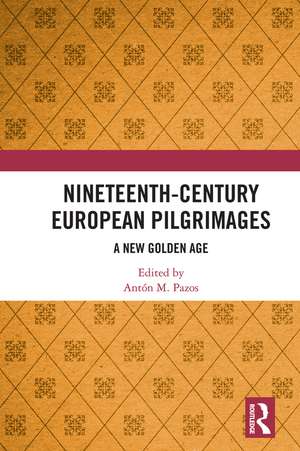Nineteenth-Century European Pilgrimages: A New Golden Age
Editat de Antón M. Pazosen Limba Engleză Hardback – 12 mar 2020
Looking at both Western Catholic and Eastern Orthodox Europe, an international panel of contributors analyse the revival of some major Christian shrines, cults and pilgrimages that happened after the rediscovery of ancient holy burial sites or the constitution of new shrines in locations claiming apparitions of the Virgin Mary. They also shed new light on the origin and development of new sanctuaries and pilgrimages in France and the Holy Land during the Nineteenth Century, which led to fresh ways of understanding the pilgrimage experience and had a profound effect on religion across Europe.
This collection offers a renewed overview of the development of Modern European pilgrimage that used intensively the new techniques of organisation and travel implemented in the Nineteenth-Century. As such, it will appeal to scholars of Religious Studies, Pilgrimage and Religious History as well as Anthropology, Art, Cultural Studies, and Sociology.
| Toate formatele și edițiile | Preț | Express |
|---|---|---|
| Paperback (1) | 387.16 lei 6-8 săpt. | |
| Taylor & Francis – 13 dec 2021 | 387.16 lei 6-8 săpt. | |
| Hardback (1) | 847.73 lei 6-8 săpt. | |
| Taylor & Francis – 12 mar 2020 | 847.73 lei 6-8 săpt. |
Preț: 847.73 lei
Preț vechi: 1140.45 lei
-26% Nou
Puncte Express: 1272
Preț estimativ în valută:
162.23€ • 168.41$ • 135.28£
162.23€ • 168.41$ • 135.28£
Carte tipărită la comandă
Livrare economică 22 martie-05 aprilie
Preluare comenzi: 021 569.72.76
Specificații
ISBN-13: 9780367188627
ISBN-10: 0367188627
Pagini: 276
Ilustrații: 14
Dimensiuni: 156 x 234 x 17 mm
Greutate: 0.45 kg
Ediția:1
Editura: Taylor & Francis
Colecția Routledge
Locul publicării:Oxford, United Kingdom
ISBN-10: 0367188627
Pagini: 276
Ilustrații: 14
Dimensiuni: 156 x 234 x 17 mm
Greutate: 0.45 kg
Ediția:1
Editura: Taylor & Francis
Colecția Routledge
Locul publicării:Oxford, United Kingdom
Public țintă
Postgraduate and UndergraduateCuprins
Introduction. Nineteenth-Century European Pilgrimages: A New Golden Age Chapter 1. The Medieval Revival: Romanticism, Archaeology and Architecture Part 1 - Jerusalem, Rome and Santiago de Compostela Chapter 2. Geopietism and Pilgrimage/Tourism to the Holy Land/Palestine at the end of the Ottoman Period (1850-1918), and the case of Thomas Cook Chapter 3. Roman Catacombs: ‘Cradle and Archives of the Catholic Church’ Chapter 4. The Rise of Secular Pilgrimage in 18th and 19th Century Rome Chapter 5. Santiago de Compostela and Diego Gelmírez: The First Golden Age of the Jacobean Pilgrimages (11th-12th centuries) Chapter 6. Compostela, Rome and the Revival of the Pilgrimages to Santiago Part 2: Western Europe Chapter 7. The Spectacle of the Modern: French Pilgrimages in the Nineteenth Century Chapter 8. The Path to Pilgrimage: Travel and Devotion in the British Press Chapter 9. Pilgrimages, Modernity, and Ultramontanism in Germany Part 3: Eastern Europe Chapter 10. Pilgrimage in Time of Trial. The Polish Struggle for Freedom Chapter 11. Orthodox Faith on the Move in Late Imperial Russia Chapter 12. Pilgrimage and the Becoming of Athonite Monasticism Chapter 13. Pilgrimage to the Miraculous Church of the Annunciation, Tinos, Greece Epilogue. The Recent Revival of Pilgrimage in Europe
Notă biografică
Antón M. Pazos is currently a member of the Pontifical Committee of Historical Sciences and Vice President of the International Commission for History and Studies of Christianity (CIHEC). He is also Deputy Director of the Instituto de Estudios Gallegos Padre Sarmiento (IEGPS), Spanish National Research Council (CSIC) in Santiago de Compostela, Spain, and a member of the editorial committees of the journals Hispania Sacra and Cuadernos de Estudios Gallegos. At the IEGPS he is the coordinator of a line of research into pilgrimage, which has been the driving force behind several research projects, especially in the organisation of the International Colloquia Compostela.
Descriere
This uniquely wide-ranging collection sets out the historic context of the formation of contemporary European pilgrimage in order to better understand its role in religious expression today.
